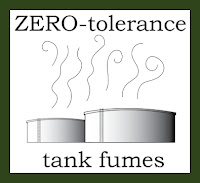ZERO TOLERANCE - TANK FUMES
Technology
has advanced since the development of the Clean Air Act in the 1970's,
and in the past ten years, detectors of hazardous air pollutants
(HAPs) have become reliable, affordable, and mobile.
This
means that direct measurements can be made on-site and on-demand if
there is suspicion that an industrial emitter of HAPs is flooding
public spaces with toxic emissions.
The
Clean Air Act sets a floor – a minimum standard – for HAPs
emissions from industrial sites. It does not set a ceiling. More
stringent emissions standards may be issued under State authority.
This State authority can be extended by the State of Maine to local
municipalities that choose to adopt stricter standards. This rule
change at the State level is what I will propose. What remains is a
question of enforcement.
When
detectors were large and expensive and centrally located, direct
measurements in real-time were difficult if not impossible to obtain.
Consequently,
Clean Air Act regulations for HAPs emissions were indirect. They
relied heavily on engineering parameters, such as on the design and
proper functioning of seals and vents, to model (as opposed measure)
the HAPs released from sites of operation.
In
addition, because of delays between measuring and getting results,
emissions are still regulated as time-averages and do not account for short-term “bursts” of high concentration – even if that high
concentration is far above safe levels of exposure. A whole year’s
worth of permitted emissions can be blasted into neighborhoods in
hours, and yet the emitter can still be in compliance according to
Federal and State regulations.
It is
time to update enforcement in a way that uses new detection
technologies.
Zero-Tolerance
policies are simple. Instead of quibbling over engineering specs and
“tolerable exposures”, local laws can be crafted to simply say:
“Zero
HAPs are permitted from industrial users into adjacent public spaces
and residential neighborhoods.”
And
now that tools are available and methods can be developed to identify
the pollutant and its source, municipalities under this new
“Zero-tolerance” authority can deploy local police powers to shut
down offending operations as they are taking place and institute
stiff fines for every minute the pollution is still detectable in
public space.
Zero-Tolerance
policies are not intended to replace existing Clean Air Act
regulations. Industrial emitters would still be obligated to report
to the Maine DEP under their licensing requirements and would still
be licensed to emit. Dilution is the longstanding solution to the
pollution. Zero-Tolerance policies simply require that the package of
air leaving the emitter’s premises is no more detectably
contaminated than the air going in. In other words, that dilution
must take place before the emissions leave the premises.
It is
true that we are all exposed to toxic pollutants from a wide array of
sources from moment to moment. This does not excuse a business model
that relies on poisoning neighborhoods. We can work to create the
toxic-free world we want, but were too unaware to notice. Now we can
know, and we can act responsibly and ethically on what we know.
See Eben Rose Webpage: https://www.ebenrose.com/
FACEBOOK: User must login
https://www.facebook.com/EbenRoseforMaineSenate/
See Eben Rose Webpage: https://www.ebenrose.com/
FACEBOOK: User must login
https://www.facebook.com/EbenRoseforMaineSenate/


Comments
Post a Comment